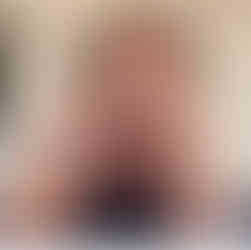Mask Innovation = Capture Aerosols & Breathe Easier
- rjnh72
- Jul 1, 2020
- 4 min read
Updated: Nov 28, 2024

I’ve challenged myself to think of something to help better fit a mask on everyone, improve breathability and overall efficacy, and enable more sustainable and sociable use. Why? Masks can make a difference to COVID19 spread, I’m a little frustrated by what I see and hear, and I have friends on the frontline
My design self-brief is “masks that are comfortable and easy to breathe through, capture particles and aerosols with high efficiency …AND enable more natural communication and interaction with a friendly face” whilst being "cheap, mass producible, re-usable (recyclable and safely disposable too), and designed to encourage grace" … i.e. pretty challenging. My innovation suggestion is an "electrostatic fabric strip to create an edge soft seal" that provides the filter function and so enables a new approach to mask design. In the pictures shown here of a quick early prototype I made at home, I use an adhesive tape to attach an electrostatic non-woven fabric as a soft seal edge to existing light weight mask often worn about these days.

My rational. The electrostatic fabric strip provides a ‘soft seal’ that filters the ‘leaky’ air electrostatically with a low pressure drop (easy-ish to breathe) and can be retro-fitted to existing masks (or easily bonded into new ones during manufacture - i am aware of some commercial fabrics that could be used too). The width of the electrostatic filter felt tape provides for airflow through a long-ish charged path length to promote aerosol capture efficiency whilst the thick open felt-like structure also slightly compresses during wear to form a comfortable soft mask-skin functional filter seal during use. The electrostatic non-woven fabric used here in my 1st prototype is an old special wool propylene blend made by CSIRO that I happened to have in my garage (I’m aware it can be recharged as part of washing and drying at home so potentially ticks the reusable box). Will it work? Yes. And it will be an improvement for mask aerosol capture as i see many masks that fit very poorly = this solves this!!.. and there is published peer reviewed literature since 1970s discussing electrostatic fabrics showing good capture potential for aerosols and I am directly familiar with some of the more recent work.
Allowing myself to dream a little more, this ‘edge filtration’ approach could be used more generally with sustainable materials or even impermeable transparent materials, and beyond improving breathability and fitted performance of existing masks, may enable new transparent masks! (i.e. replace the fabric with a shaped sustainable plastic?)…perhaps even ones that include a covid diagnostic?. It’s an unusual design approach for masks and can only really be tested and validated in functional form fit tests. Anyway, here’s a few pictures of playful mockups I made to explore the ideas...one using clear plastic mask packaging so my friends with hearing challenges can read my lips and see me smile!
Whilst I’m confident this approach is well worth exploring it needs scientific resources like access to certified testing, and this approach will require fit based tests that aren’t common in Australian labs (as opposed to fabric performance tests often used for mask accreditation that ultimately ‘assume’ proper fit in use!?!?)...the reality is with populations of people ‘mask fit’ is a big challenge. Ideally, an impact and cost benefit modelling study on filtration efficacy coupled to covid spread modelling (including various personal exposure profile casestudies) would be done too. Hopefully there is someone out there who can help take the concept beyond a suggestion…??...*
* Note: I haven’t checked on IP for this concept -- if there isn’t any then the concepts described herein are my gift to the public domain!.
About the Author: Dr Helmer has worked in advanced materials and processing research and innovation for over 20 years. His filtration knowledge began as part of his undergraduate Chemical Engineering degree and developed further during his PhD where he conceived industrial paperforming as a ‘boundary layer filtration’ process and in 2000 he transferred his PhD technology to CSIRO Forestry and Forest Products (now defunct) for commercial industrial research. In 2003 he moved to CSIRO Textile & Fibre Technologies (now defunct) and whilst researching adding smart functionality to textiles undertook studies into both liquid filtration (e.g. smart diapers, see 1) and air filtration (electrospun paper filters, see 2) and became familiar with colleague’s filter media testing, particle counting & measurement techniques, electrostatic filtration, and nanofibre membranes for fine particle capture from air (see 3). Around this time, and in response to the SARS epidemic and other biosecurity concerns, he and colleagues proposed a ‘smart filter concept’ seeking to capture, sense, inform and respond to airborne biosecurity threats (like H1N1 virus) though that proposal failed to attract sufficient funding interest to progress at that time. Whilst Richard has maintained a general interest in this area (e.g. see 4 & 5), he is no longer part of a research group with access to fabric and filter preparation and testing capabilities.
References
5







